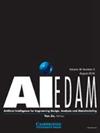Protobooth: gathering and analyzing data on prototyping in early-stage engineering design projects by digitally capturing physical prototypes
IF 2.3
3区 工程技术
Q3 COMPUTER SCIENCE, ARTIFICIAL INTELLIGENCE
Ai Edam-Artificial Intelligence for Engineering Design Analysis and Manufacturing
Pub Date : 2020-09-24
DOI:10.1017/S0890060420000414
引用次数: 20
Abstract
Abstract Aiming to help researchers capture output from the early stages of engineering design projects, this article presents a new research tool for digitally capturing physical prototypes. The motivation for this work is to collect observations that can aid in understanding prototyping in the early stages of engineering design projects, and this article investigates if and how digital capture of physical prototypes can be used for this purpose. Early-stage prototypes are usually rough and of low fidelity and are thus often discarded or substantially modified through the projects. Hence, retrospective access to prototypes is a challenge when trying to gather accurate empirical data. To capture the prototypes developed through the early stages of a project, a new research tool has been developed for capturing prototypes through multi-view images, along with metadata describing by whom, why, when, and where the prototypes were captured. Over the course of 17 months, this research tool has been used to capture more than 800 physical prototypes from 76 individual users across many projects. In this article, one project is shown in detail to demonstrate how this capturing system can gather empirical data for enriching engineering design project cases that focus on prototyping for concept generation. The authors also analyze the metadata provided by the system to give understanding into prototyping patterns in the projects. Lastly, through enabling digital capture of large quantities of data, the research tool presents the foundations for training artificial intelligence-based predictors and classifiers that can be used for analysis in engineering design research.Protobooth:通过数字捕获物理原型,收集和分析早期工程设计项目中的原型数据
摘要为了帮助研究人员捕捉工程设计项目早期阶段的输出,本文提出了一种新的数字捕捉物理原型的研究工具。这项工作的动机是收集有助于在工程设计项目的早期阶段理解原型设计的观察结果,本文研究了物理原型的数字捕获是否以及如何用于此目的。早期阶段的原型通常是粗糙的,保真度低,因此在项目中经常被丢弃或大幅修改。因此,在试图收集准确的经验数据时,对原型的回顾性访问是一个挑战。为了捕捉在项目早期阶段开发的原型,开发了一种新的研究工具,用于通过多视图图像捕捉原型,以及描述谁、为什么、何时以及在哪里捕捉原型的元数据。在17个月的时间里,该研究工具已被用于从许多项目的76名个人用户中捕获800多个物理原型。在本文中,详细展示了一个项目,以演示该捕获系统如何收集经验数据,从而丰富工程设计项目案例,这些案例侧重于概念生成的原型设计。作者还分析了系统提供的元数据,以了解项目中的原型模式。最后,通过实现对大量数据的数字捕获,该研究工具为训练可用于工程设计研究分析的基于人工智能的预测因子和分类器奠定了基础。
本文章由计算机程序翻译,如有差异,请以英文原文为准。
求助全文
约1分钟内获得全文
求助全文
来源期刊
CiteScore
4.40
自引率
14.30%
发文量
27
审稿时长
>12 weeks
期刊介绍:
The journal publishes original articles about significant AI theory and applications based on the most up-to-date research in all branches and phases of engineering. Suitable topics include: analysis and evaluation; selection; configuration and design; manufacturing and assembly; and concurrent engineering. Specifically, the journal is interested in the use of AI in planning, design, analysis, simulation, qualitative reasoning, spatial reasoning and graphics, manufacturing, assembly, process planning, scheduling, numerical analysis, optimization, distributed systems, multi-agent applications, cooperation, cognitive modeling, learning and creativity. AI EDAM is also interested in original, major applications of state-of-the-art knowledge-based techniques to important engineering problems.

 求助内容:
求助内容: 应助结果提醒方式:
应助结果提醒方式:


